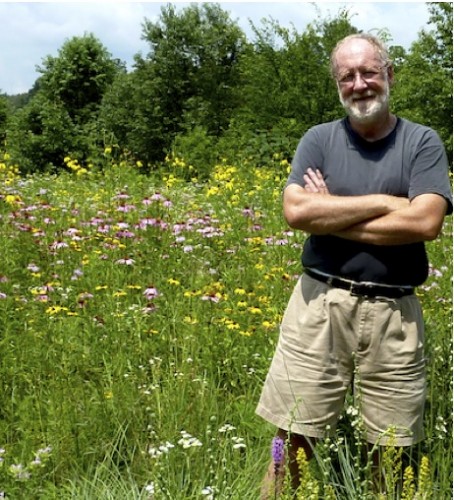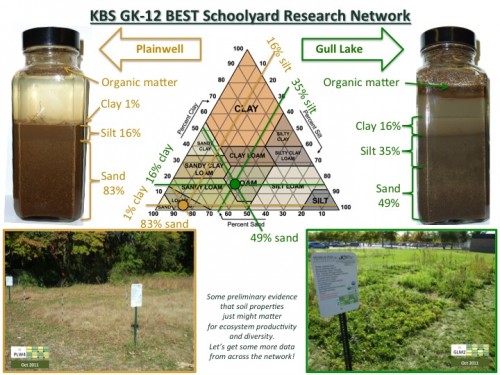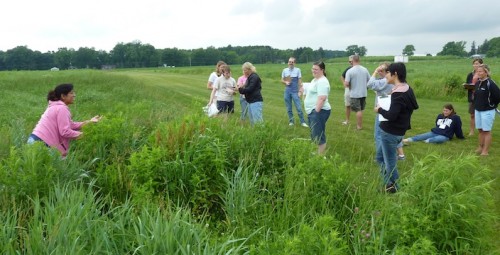A Brief Autumn Update on the BEST Plots Research Project from Tom Getty

I want to share some information and my excitement about our progress on the GK-12 Bioenergy Sustainability Project. We have all put in a tremendous amount of work to design and establish the BEST Schoolyard Research Network and to develop lesson plans that capitalize on the inquiry opportunities the network creates. Now the data is beginning to come in. At our next workshop we will begin some quantitative analysis of the early results.
Recall that our BEST research network is designed to mimic aspects of the Great Lakes Bioenergy Research Center (GLBRC) Sustainability Research Project. Our overarching question is “Can We Grow Our Fuel and Our Flowers and Butterflies Too?” Under this broad umbrella we can address many basic and applied issues in science and ecology. We are particularly interested in understanding whether we can have high plant productivity, which could be converted to fuel, and maintain other “ecosystem services” related to plant and animal diversity.
To address these questions, we have implemented a very ambitious experiment that in some ways goes well beyond the GLBRC design. We have three experimental control variables, each having two values: 1. Seed type: switch grass vs mixed prairie, 2. Fertilized vs not-Fertilized, and 3. Harvested vs not-Harvested. These three treatments are “crossed” to create a block of eight treatment plots.

The block of eight treatment plots is replicated 38 times in schoolyards across SW Michigan. The positions of the treatments in the blocks are varied across blocks, to “randomize away” any possible inadvertent position effects. For instance, if being on the south side increases sunshine and productivity and we always planted switchgrass on the south side, we might mistake a position effect (being on the south side increases productivity) for a treatment effect (switch grass is more productive than prairie). We “control” for this possibility statistically by having every treatment plot on the south side in half of the blocks and on the north side in the other half.
We have some replicated blocks within districts so students can see the impacts of what scientists call “random noise,” like for instance, the groundhog burrow in one of the two Delton High School blocks, and the apparently random establishment of a few very large “volunteer” mullein plants in one of the Parchment Administration Building blocks. Nature is like that and we have to deal with it when we want to draw conclusions about the effects of our experimental treatments. Imagine if we had only one block and a groundhog just happened to establish a burrow in the fertilized, un-harvested prairie plot? Would we conclude that fertilized, un-harvested prairie plots produce more groundhogs than un-fertilized, harvested prairie plots?
We also have blocks of plots replicated across 22 locations in 14 districts scattered over more than 1000 square miles. We expect the effects of our experimental treatments (seed type, fertilization, harvest) on our dependent variables (plant productivity, plant and invertebrate diversity) will depend on uncontrolled local soil and landscape variables. For instance, we might hypothesize that productivity will depend on local soil properties, and that the effects of fertilization will be greater in locations with nutrient-poor sandy soils than in nutrient-rich loamy soils. Preliminary data from Plainwell and Gull Lake suggests that uncontrolled variation in local soils and landscapes is indeed going to be an important part of our experiment and our conclusions.

These sorts of uncontrolled local soil and landscape effects highlight the value of having an integrated research network across a diversity of locations. A big challenge in drawing conclusions from scientific studies is knowing how broadly we can apply (“generalize”) the results. A familiar example of this challenge is concern about whether studies of the effectiveness of pharmaceutical drugs in mature white males tells us about their effectiveness in young African-American women. If our BEST Plots were only placed on highly productive soils like those at the GLBRC main site, we would only be able to draw conclusions about the relationship between our treatments (ex: switch vs prairie) and our dependent variables (ex: productivity) in “good corn ground.”
This is genuine research that creates an excellent opportunity to learn about experimental design, data analysis and the role of science in addressing human needs. It is also very relevant to the specific goal of determining whether we can produce bioenergy from “marginal” lands that are not being used for food production. It looks like we have an excellent sample of “marginal” land in our network, as well some highly productive sites. I’m pretty sure our network encompasses a range of conditions that far exceeds those being studied on the GLBRC main site at KBS. Data from the entire range of BEST Plot sites is invaluable. What a great opportunity!
In late November or early December, after all the Autumn protocols are completed, I will cut down all the vegetation, to tidy up the plots. Then I will “harvest” the four Harvested plots by raking the cut vegetation off of those plots. In the unHarvested plots the cut vegetation will be left to decompose and recycle. The fertilization treatment will begin next year. Next year we will probably re-seed a few of the blocks on very sandy soil because they had such poor germination last year. More on that later.
We are looking forward to many exciting discoveries and learning opportunities over the next several years. Please help us make this the BEST possible experience for everyone.
Thanks,
Tom Getty
 The NSF GK-12 program is meant to advance the professional development of STEM graduate students while they continue to make good progress on their dissertation research. NSF stipulates that fellows will spend a maximum of 15 hours per week directly involved in GK-12 project activities, with approximately 10 of these hours devoted to activities in K-12 partner districts or at KBS. KBS activities will include a one-day orientation in May, an intensive summer science institute in late June, four one-day school year workshops and Friday fellows meetings associated with a course focused on the professional development of fellows.
The NSF GK-12 program is meant to advance the professional development of STEM graduate students while they continue to make good progress on their dissertation research. NSF stipulates that fellows will spend a maximum of 15 hours per week directly involved in GK-12 project activities, with approximately 10 of these hours devoted to activities in K-12 partner districts or at KBS. KBS activities will include a one-day orientation in May, an intensive summer science institute in late June, four one-day school year workshops and Friday fellows meetings associated with a course focused on the professional development of fellows.


